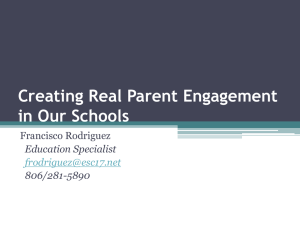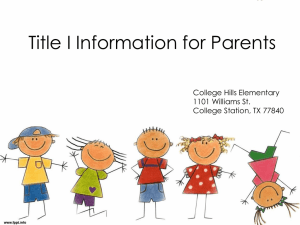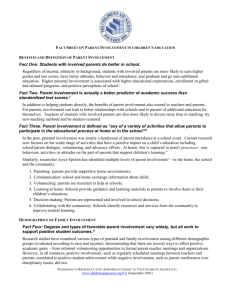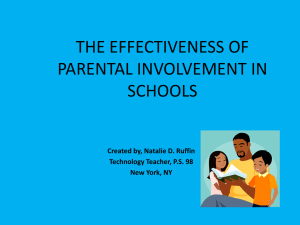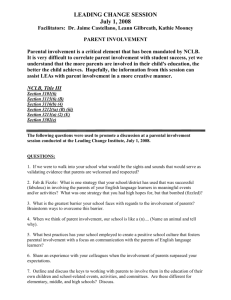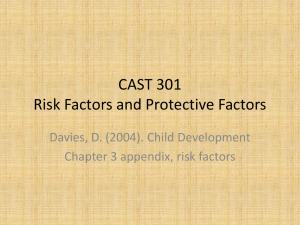Self-esteem Definition
advertisement
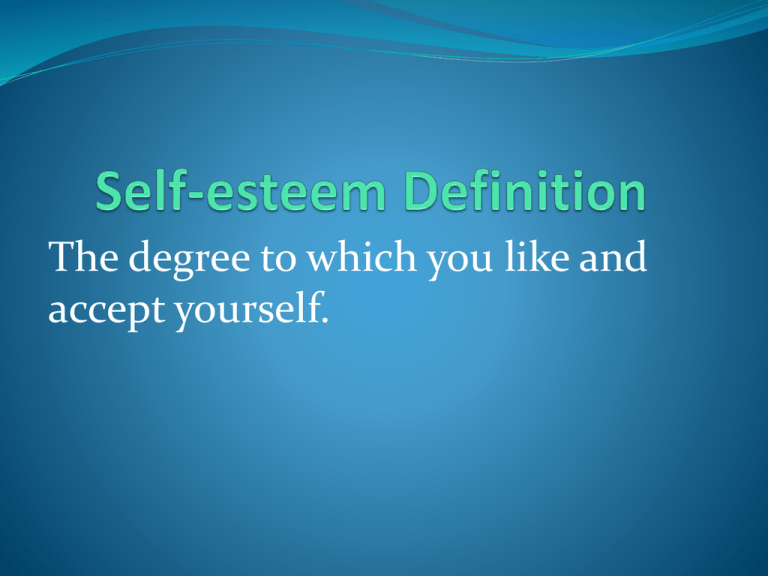
The degree to which you like and accept yourself. Where Do We Get Self-esteem? 1. Parental Messages 2. Cultural/Societal Messages Parental Messages Healthy messages include saying, “it’s okay to make mistakes……daddy/momm y loves you always.” Unhealthy parents use weapons such as isolation, ridicule, abuse, deny, invalidation, and shame to get their children to obey and then withdraw their love until they do obey. The 7 Parental Circumstances That Cause Low Self-Esteem 1. Parental rejection – “You were an accident,” “You make me drink,” or parent is preoccupied with themselves, their work, or spouse and child feels neglected. 2. Parental overindulgence – “Spoiling the child.” The child that gets everything grows up unable to achieve goals or discipline themselves and take responsibility. 3. Parental Over protectiveness – These good intentions create children who never learn to trust the world, they feel insecure, and lack self-confidence to succeed. Circumstances That Cause Low Self- Esteem (continued) Overly critical parents – Setting high standards of behavior, these children become adults who always feel guilty or not good enough causing anxiety disorders and depression. 5. Parental abuse – (Physical, Verbal, Sexual) Creates adults who can’t trust, feel inadequate, and lack ability to be intimate. They become a victim or a bully. 6. Parental alcoholism or drug abuse – This chaotic and unreliable atmosphere creates mistrust and can deny their own feelings letting others “walk all over them.” 7. Major childhood loss – The death of a parent or divorce can create issues of abandonment and feel devastated by future losses and an over-dependency on others or on substances. 4. Cultural/Societal Messages “Don’t affirm your cultural heritage” “Don’t’ be different” “Don’t be separate” “You’re not like us” “You are flawed” “You are inferior” “You are a criminal/animal” The Media Movies Advertisements Television Teachers Books They can isolate, polarize, distort, invalidate, discriminate and coerce minorities into believing they are inferior beings. 7 Steps to Building High Selfesteem Step 1 - Communicate with your Inner Child – the little boy/girl inside you who feels your deepest emotional needs for trust, love, affection, and security. Let this inner child express themselves instead of suppressing/scolding by: - Healing Mother and Father Wounds Using Visualization and telling them what you needed from them. - Write a Letter to Your Inner Child – Use the 3 ego personalities to communicate: the parent, child, and adult. 7 Steps of Building High Selfesteem (continued) Step 2 - Schedule Self-care Activities: Ask is your need for the following fulfilled? Need for friendship…….join clubs, groups, and set up fun gatherings Need for Respect…..learn to set boundaries; see chapter 8 Need for Affection…..learn to give hugs and pats on the back Need for God…..put in time for prayer, meditation, and join a group Need for creative expression…..try music, painting, drawing, writing, etc. Need for fun and play…..schedule movies, dances, walks, massage, music Need for serving others…..serve in hospitals, shelters, social service agenc. Need for intimacy……learn to be vulnerable with others Need for trust/loyalty…..spend more time with people you can rely on 7 Steps of Building High Selfesteem (continued) Step 3 – Write a Support Letter to Yourself Anger Hurt Fear Regret Intention Love Write with your opposite hand to feel like the child you once were. 7 Steps of Building High Selfesteem (continued) Step 4 – Surround yourself daily with positive, supportive, and encouraging people. Step 5 – Read, listen, and watch personal growth material. Step 6 – Practice getting approval from yourself instead of from others. Make a list of people you need approval from and let go of this need through EFT, journaling, etc. Step 7 – Become skilled or knowledgeable in at least one subject area or thing that you enjoy such as music, sports, politics, social problems, nutrition, art, parenting, gardening, spirituality, history, culture, cooking, etc. The 4 Stress Sub-personalities 1. 2. 3. 4. 5. The Worrier – They create mental worst case scenarios and what if statements. They overestimate the odds. The Perfectionist – They believe their efforts are never good enough and should be working harder. Ask the questions above to combat your inner perfectionist. The Critic – Constantly negatively judging themselves maximizing their weaknesses and minimizing strengths. “You are so stupid,” (Show Chris Farley Video) The Victim – They feel helpless and hopeless, defective, and use words like “I can’t or I’ll never be able to…” Ask these questions for all types: Ask what is the evidence, is it always true, what are the odds, what is the big picture?


